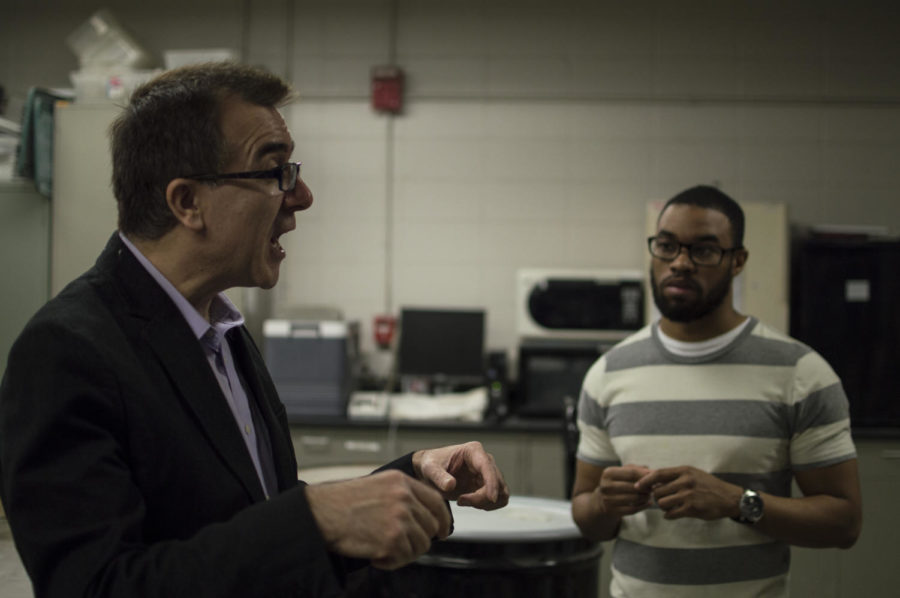ISU researchers develop snow-free pavement technologies
March 12, 2015
Last week, a passenger jet skidded off an icy runway while landing during a snowstorm at New York’s LaGuardia Airport. The accident caused several injuries, damage to the aircraft and temporary closure of the entire airport.
Incidents like these are exactly what a group of ISU researchers is hoping to prevent in the future.
Dr. Halil Ceylan, associate professor of civil, construction and environmental engineering, and his team are working on technologies that can prevent any kind of pavement from becoming ice or snow-covered.
“It takes maintenance crews a lot of time to clear ice and snow, and still that thin layer of ice is there,” Ceylan said. “That’s where you have black ice formations. It reduces your traction.”
Ceylan and his team of 19 faculty, lab staff, and graduate students are in the midst of a three-year, $1.5 million project funded by Iowa State and the Federal Aviation Administration.
The group has developed three techniques to keep pavements clear. The first, called electrically conductive concrete, utilizes an electric current to heat the pavement and melt away ice and snow.
According to graduate student Alireza Sassani, the concrete is made using a carefully prepared blend of cement and electrically conductive carbon fibers.
“We can’t just simply mix them into concrete. We use a special mixing procedure and special chemicals to make [the fibers] more functional,” Sassani said.
Wiring is then run through the concrete and attached to a power source. When the power is turned on, the wires heat up and begin heating the entire concrete layer.
Using a small test block and an infrared thermometer, Sassani and fellow graduate student Ali Arabzadeh demonstrated how effective the system is. Within a few minutes of heating, the block’s surface soars from room temperature to 151 degrees, more than enough to melt snow.
“The heating starts basically on the top,” Sassani said. “We want to heat up the surface more than the other parts.”
To keep the concrete from wasting energy and getting too hot, the team will develop a system of sensors to regulate the temperature.
“It’s like your thermostat in your house. You’ll be able to control it yourself,” Ceylan said.
The second, similar method uses a system of pipes that circulate heated liquids, such as glycol, through the pavement. Ceylan demonstrated this by placing a test slab of concrete in a walk-in freezer. A small pump then circulates liquid through the slab, clearing it of snow despite the cold temperatures.
The team’s third technology doesn’t need heat or electricity to keep pavement clear.
Graduate student Therin Young demonstrates this using only water and an ordinary-appearing block of concrete divided in half. He tilts the block’s surface and squeezes several drops of water onto each half.
The water on the first half slowly dribbles down the surface, then soaks into the concrete’s pores. The drops hitting the second half quickly fly off the pavement, barely making contact with the surface.
The second half, Young explains, has been sprayed with a special coating similar to those on non-stick frying pans.
“We’re using Teflon powder, and in order to make it stick, we’re also using an epoxy resin,” Young said.
Young sprays each ingredient on layer-by-layer. The Teflon helps the pavement repel water, while the epoxy resin keeps the coating from wearing off. According to Young, the biggest challenge is creating a durable coating for runways that can withstand heavy air traffic.
“That’s going to be the biggest question. We’re going to do tests where we measure how durable the coatings on the surface are,” Young said.
Ceylan hopes the team can begin field testing the technologies soon, perhaps in airports like Des Moines and Minneapolis-St. Paul, before moving to smaller general aviation airports.
“In regular airports, you have to buy snowplows, you have to have a garage, you have to maintain all of these vehicles,” Ceylan said. “If you implement these technologies, you can eliminate all of those things, or reduce the numbers significantly.”
According to Ceylan, the savings will translate far beyond maintenance costs.
“Our goal is to keep airports open and accessible during winter weather, and to cut delays and flight cancellations as much as possible,” Ceylan said. “We’ll provide a safe working environment for airline and airport personnel, and the travelling public.”
The team hopes their technologies will eventually be implemented in paved surfaces everywhere.
“Our research will have a lot more impact than airports,” Ceylan said. “It will have an impact on the road infrastructure systems, bridge infrastructure systems [and] even the city sidewalks.”

















